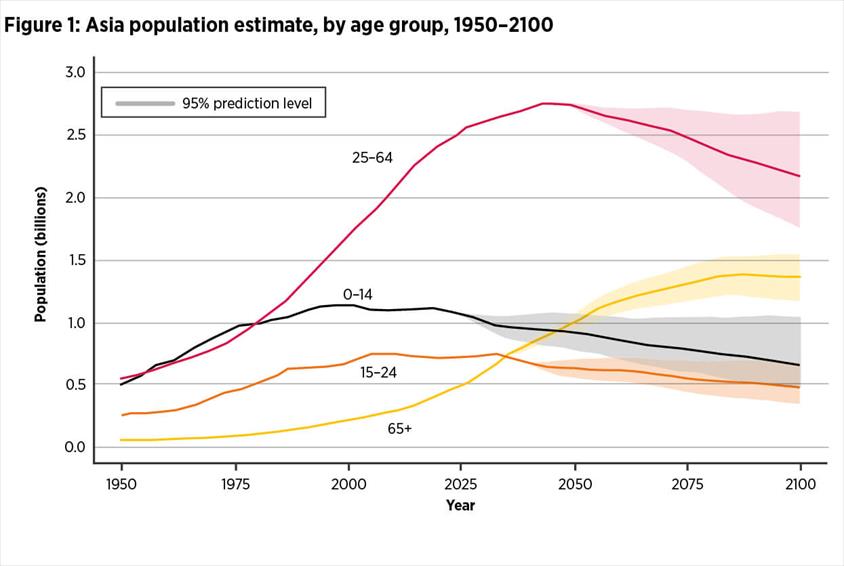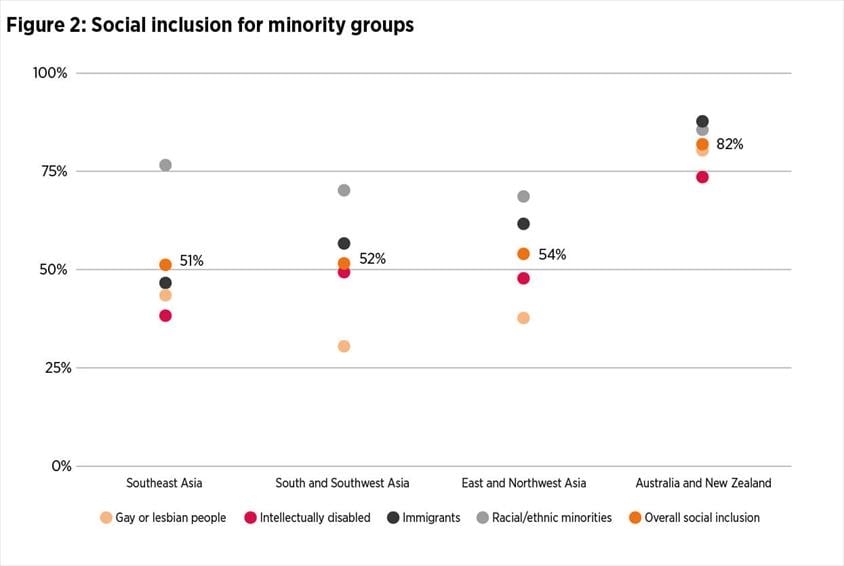Population dynamics: Creating pathways for your future workforce
Using an Asia-Pacific case study, Björn Andersson, Director of UNFPA Asia-Pacific Regional Office, discusses the opportunities for workforce diversity and how to remove barriers
Using an Asia-Pacific case study, Björn Andersson, Director of UNFPA Asia-Pacific Regional Office, discusses the opportunities for workforce diversity and how to remove barriers
Since 1950, the world’s population has increased each year, and by November 2022, it was estimated to reach 8 billion people. However, demographic data suggests that the working-age population (15–64-year-olds) will slowly decrease through to 2040, meaning that talent pools and the number of workers are shrinking.
Businesses will be faced with a labour drought that will only be exacerbated by decreasing fertility rates, ageing populations and declining immigration (Lightcast 2022). However, the picture looks very different in the Asia-Pacific region. We draw on two case studies to show the impact of demographic change over the next 30 years on one developing nation (Bangladesh) and one developed nation (Japan).
There are an estimated 4.9 billion people in Asia-Pacific, which accounts for 63% of the world’s population. This region has the largest population globally, predominantly due to China and India.
In terms of the population composition, the Asia-Pacific region has an estimated:
As shown in Figure 1, it’s estimated that the region will reach its highest number of working-age population in the next 20 years. The elderly population will outnumber the youth population in the next 30 years.

Source: World Population Prospects 2022.
So, what do these figures mean for the future workforce?
Having the largest population of young people in history offers many opportunities to benefit from a ‘demographic dividend’. This is when a country has a large working-age population compared with the non-working-age populations (for example, those aged under 14 and those aged over 65). Countries with the greatest demographic opportunity for development are those entering a period in which the working-age population has good health, quality education, employment opportunities and a lower proportion of young dependants. When this happens, the national economic payoff can be substantial. Predictions suggest that many countries in Asia are entering a demographic dividend period over the next 25 years, providing an opportunity to develop their workforce and improve productivity.
Using the examples of Bangladesh and Japan – two countries transitioning to a more mature population – we can look at the potential impact and opportunities within a developing and developed country.
In 2022, Bangladesh has a total population of 164 million – with an estimated 65% of working age. Its working-age population is estimated to continue increasing until 2050. Although the country’s birth rate started declining sharply in the 1970s, the total population will continue growing until 2060, when it is estimated to start to decline. The country is ageing fast, and the population aged 65 years and older will increase from 7% in 2030 to 16% in 2050.
These changes present Bangladesh, and organisations operating in this region, with a window of opportunity from 2022 to 2050. As well as a growing working-age population, we’ve seen some positive trends in female workers. Historically, Bangladesh has had a low female workforce participation rate; however, we’ve seen an increase of female workers from 30% in 1990 to 44% in 2021. The number of women completing secondary education has increased from 29% in 2011 to 50% in 2020. Policy-makers and senior leaders of businesses should focus on attracting, recruiting and developing more women at all levels, to capitalise on this growing availability of talent. This will increase the number of women in more senior positions and lead to greater gender diversity across the workforce.
In 2022, Japan has a total population of 125 million – with an estimated 54% of working age. Japan has the world’s oldest population, which is decreasing at an accelerating rate. About 29% of its total population are 65 years or older, with a higher proportion of this group being women. In 2000, Japan reached its highest number of people of working age (55 million). This sharply decreased to 43 million in 2020, which is a 2.4% decline per year. Impacting this are two factors: Japan’s low birth rate and immigrating to Japan being difficult. The ‘silver economy’ policy in Japan aims to address a rapidly ageing population (and workforce) in Japan by:
A healthy labour force and increased employment opportunities are key to maximising their ‘silver dividend’.
1. The impact of traditional social norms
While some aspects of society in Asia are undergoing major changes, other dimensions have been resistant, reinforcing traditional norms. Figure 2 shows survey data highlighting attitudes across the Asia-Pacific region towards four social groups: racial or ethnic minorities, immigrants, people living with disabilities, and gender minorities. These results highlight how some regions continue to hold social beliefs that are discriminatory towards certain groups. For example, South-East Asia is relatively positive towards racial and ethnic minorities, but less tolerant towards immigrants, people living with a disability, and lesbian, bisexual, gay, transgender and queer+ (LBGTQ+) people. Compared with regional leaders Australia and New Zealand, the rest of the region still lags far behind, by around 30% in terms of average inclusion level of the four minority groups above.

Note: Percentage of respondents reporting favourable attitudes towards people of the selected minority group. Overall social inclusion is an average of responses to four groups.
Source: Gallup World Poll
2. Social norms and women in employment
In the Asia-Pacific region, social norms and values can have a negative impact on women, in terms of educational opportunities and gaining employment. They reinforce traditional expectations of women remaining the main caregivers of children and the elderly, resulting in women having lower levels of education and earning less than men.1 Even in more developed countries, there are examples of discriminatory laws or practices, for example in Japan and Korea, where women are regularly asked in job interviews whether they plan to have a family in the future.2
However, change is on the horizon. Within the last two years, 65 countries have implemented 100 legal reforms aimed at increasing women’s economic opportunities. But more changes are needed, especially given that half of the countries in Asia do not have any laws that protect against gender discrimination in the workplace. Only six countries have laws that are intended to close gender pay gaps: Australia, Kiribati, Samoa, the Philippines, Vietnam and Bhutan, so there is certainly more to be done in the region.3
These findings are globally significant. Business leaders need to look ahead, and use insights derived from data to anticipate demographic shifts. They should address talent gaps by investing in and creating employment opportunities for those entering the workforce. Here are six key takeaways to consider:
MENA has the largest youth population in the world and the highest youth unemployment rate, especially within women - making gender diversity an economic and business imperative.
The UK is experiencing a post-pandemic trend of older workers becoming economically inactive - two thirs of this can be explained by population profile changes.
With more than half of 25-64-year-olds having higher education qualifications, we've seen increased productivity and job quality, resulting in high economic growth rates post-pandemic.
Prior to this role, Björn served as Chief of Staff to two Executive Directors of UNFPA. He has almost three decades of extensive experience in international development cooperation, with key positions in programme management, policy development and strategic organisational management within the UN system and government agencies, including as Director of the Department for Development Policy at the Ministry for Foreign Affairs of Sweden between 2008 and 2013.
Tackling barriers to work today whilst creating inclusive workplaces of tomorrow.
Discover our practice guidance and recommendations to tackle bullying and harassment in the workplace.

Research on how an employee's socioeconomic background or class affects their development opportunities and how to maximise social mobility in the workplace

Dedicated analysis of job quality and its impact on working lives in Scotland

Understanding how your organisation compares can enable you to stay ahead, retain valuable employees, and understand the cost of attrition to your organisation

The CIPD Good Work Index provides an annual snapshot of job quality in the UK, giving insight to drive improvement to working lives

Monthly round-up of changes in employment law in the UK

Research on how an employee's socioeconomic background or class affects their development opportunities and how to maximise social mobility in the workplace

We look at the main focus areas and share practical examples from organisations who are optimising their HR operating model

Ben Willmott explores the new Labour Government strategies to enhance skills and employment to boost economic growth